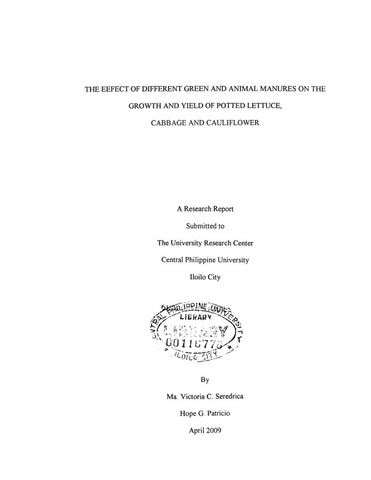Показать сокращенную информацию
The effect of different green and animal manures on the growth and yield of potted lettuce, cabbage and cauliflower
| dc.contributor.author | Seredrica, Ma. Victoria C. | |
| dc.contributor.author | Patricio, Hope G. | |
| dc.date.accessioned | 2021-03-24T07:37:10Z | |
| dc.date.available | 2021-03-24T07:37:10Z | |
| dc.date.issued | 2009-04 | |
| dc.identifier.citation | Seredrica, M. V. C. & Patricio, H. G. (2009). The effect of different green and animal manures on the growth and yield of potted lettuce, cabbage and cauliflower (Research report). Jaro, Iloilo City: University Research Center, Central Philippine University. | en_US |
| dc.identifier.uri | https://hdl.handle.net/20.500.12852/668 | |
| dc.description | Abstract only | en_US |
| dc.description.abstract | The three crops were planted at different dates at three weeks interval at the back of the College of Agriculture Building. Lettuce was sown first in August 13 and harvested on October 24, 2007; Cabbage from September 4, 2007 to February 25, 2008; and Cauliflower from September 26, 2007 to January 22, 2008. The objectives of the study were to determine the growth and yield and profitability of growing potted cabbage, cauliflower and lettuce as influenced by different green plant and animal manures. Seven experimental treatments included kamachile leaves, ipil-ipil leaves, madre de cacao leaves, poultry manure, commercial organic fertilizer, commercial synthetic fertilizer and the control (without fertilizer). These treatments were laid out in a randomized complete block design (RCBD) with three replications. Results revealed that all agronomic characteristics of the three crops were significantly (p <0.05) affected by the different manures applied. The data show that the growth and yield of lettuce, cabbage and cauliflower fertilized with kamachile manure, ipil-ipil manure, madre de cacao, poultry manure and inorganic fertilizer were significantly better than those of plants which were either unfertilized or fertilized with commercial compost. Cost and return analysis indicate that among the different manures in lettuce, ipil-ipil manure resulted in the highest ROI of 103.71%. That of the unfertilized plants was -70.10. In cabbage, only the addition of poultry manure gave a positive ROI (38.28 %). All the other treatments gave a negative ROI (-14.45% to 100%). On the other hand, none of the treatments used in cauliflower resulted in a positive ROI. The negative ROI indicate that the nutrient supplied by the manure are not enough to support the needs of cabbage and cauliflower for them to give economic yield. | en_US |
| dc.format.extent | viii, 41 leaves | en_US |
| dc.language.iso | en | en_US |
| dc.rights | Attribution-NonCommercial-NoDerivs 3.0 Philippines | * |
| dc.rights.uri | http://creativecommons.org/licenses/by-nc-nd/3.0/ph/ | * |
| dc.subject.ddc | GSL 630.72 Se66 | en_US |
| dc.subject.lcsh | Green manure crops | en_US |
| dc.subject.lcsh | Lettuce--Fertilizers | en_US |
| dc.subject.lcsh | Cabbage--Fertilizers | en_US |
| dc.subject.lcsh | Cauliflower--Fertilizers | en_US |
| dc.subject.lcsh | Fertilizers--Effectiveness | en_US |
| dc.title | The effect of different green and animal manures on the growth and yield of potted lettuce, cabbage and cauliflower | en_US |
| dc.type | Technical Report | en_US |
| dcterms.accessRights | Limited public access | en_US |
| dc.description.bibliographicalreferences | Includes bibliographical references | en_US |
Файлы в этом документе
Данный элемент включен в следующие коллекции
-
Research reports [167]



